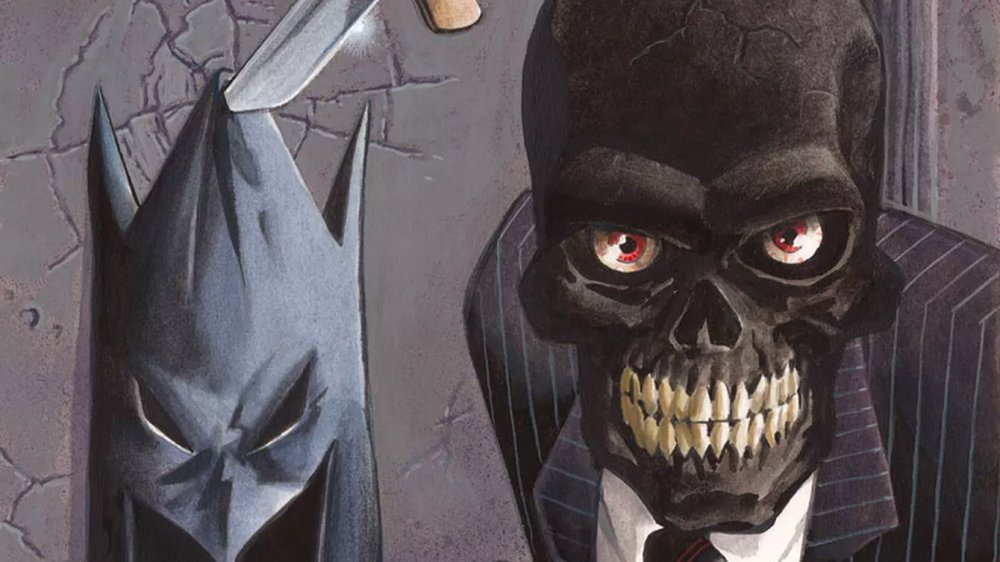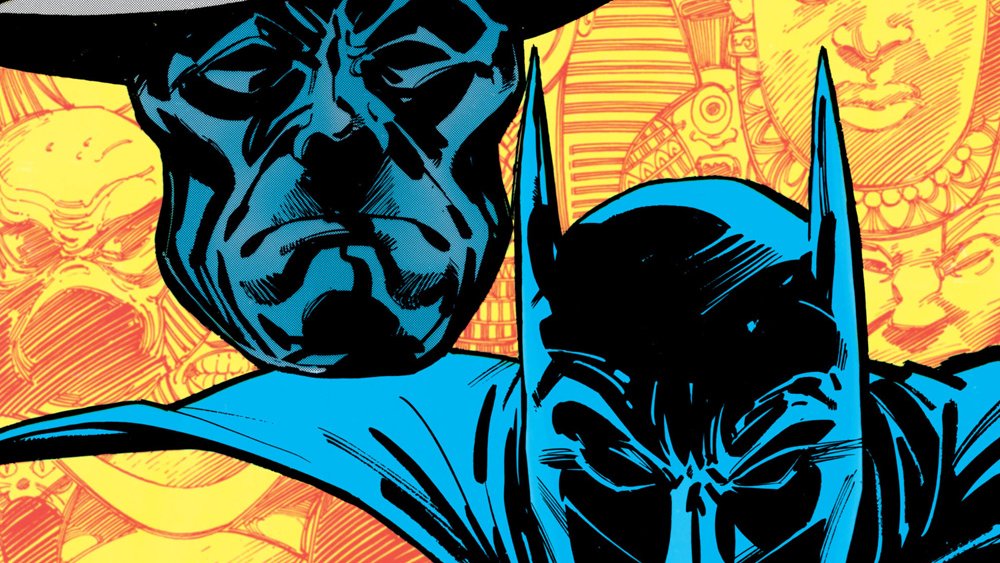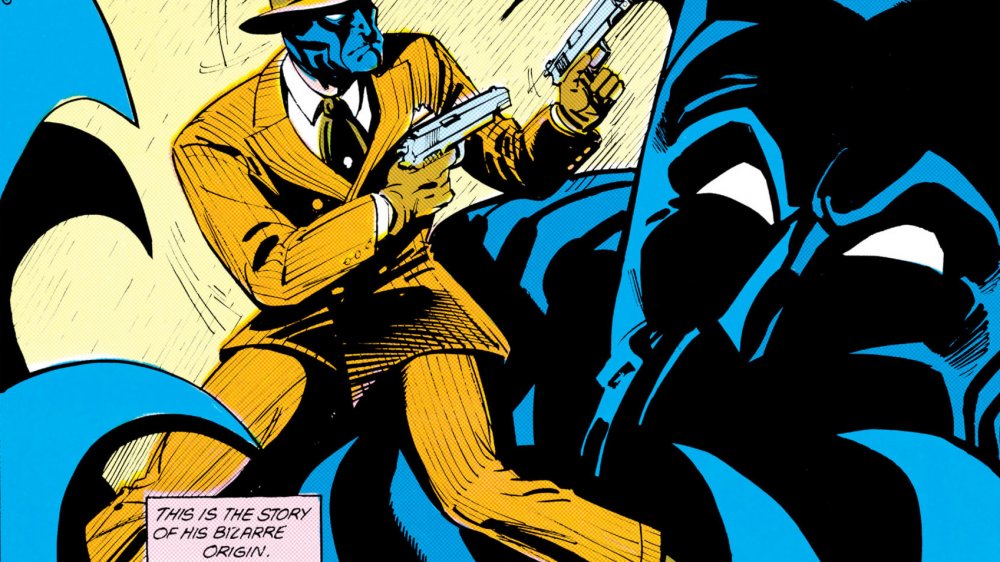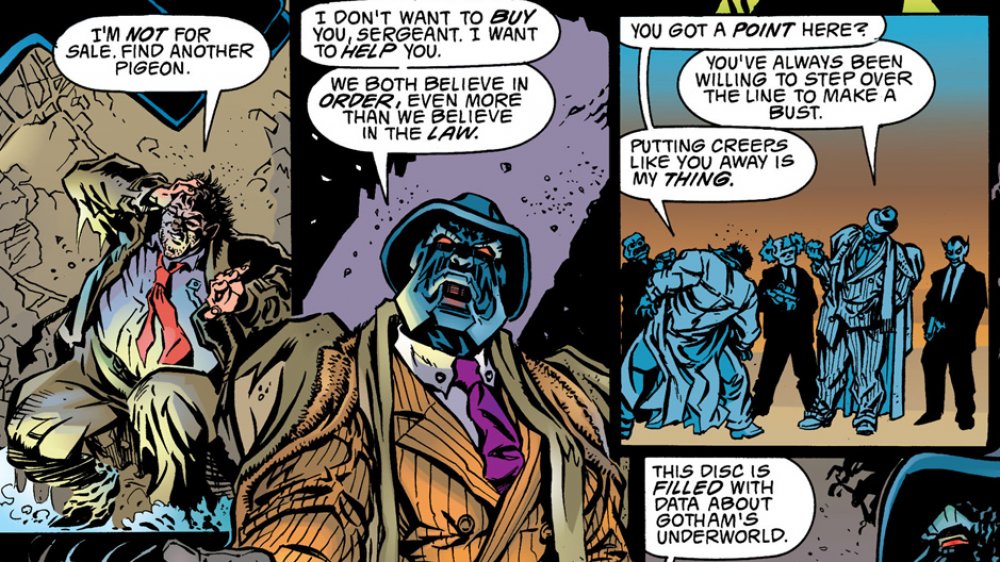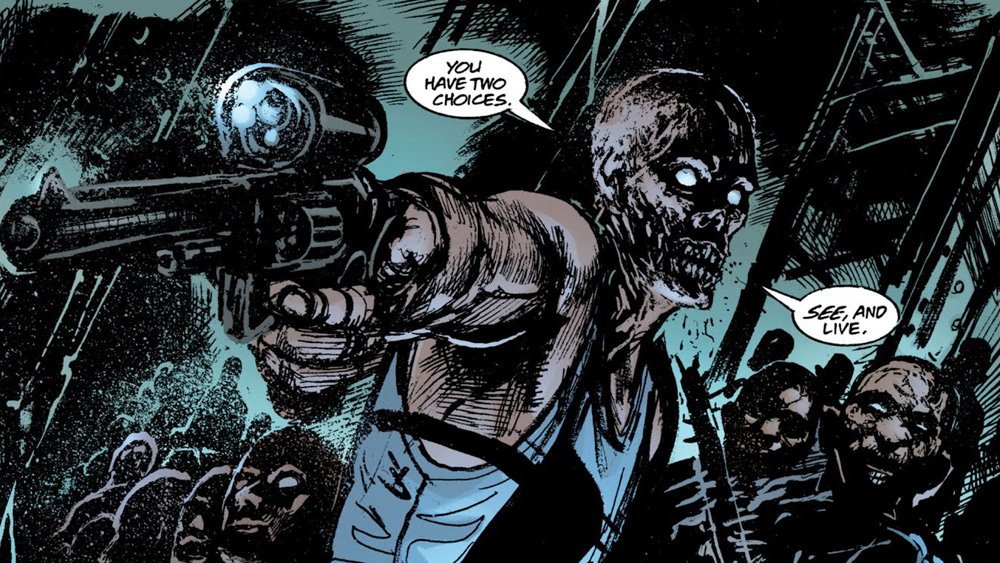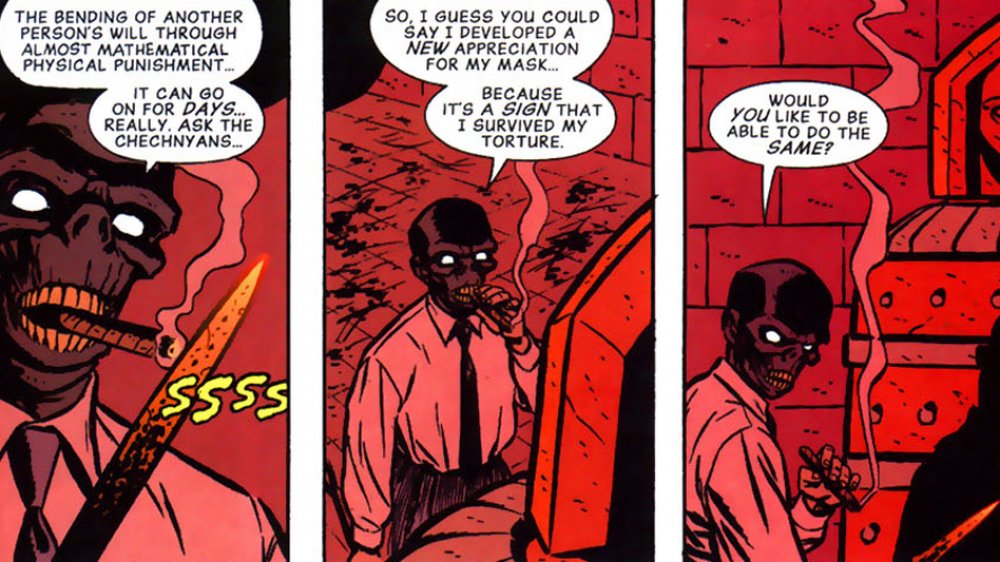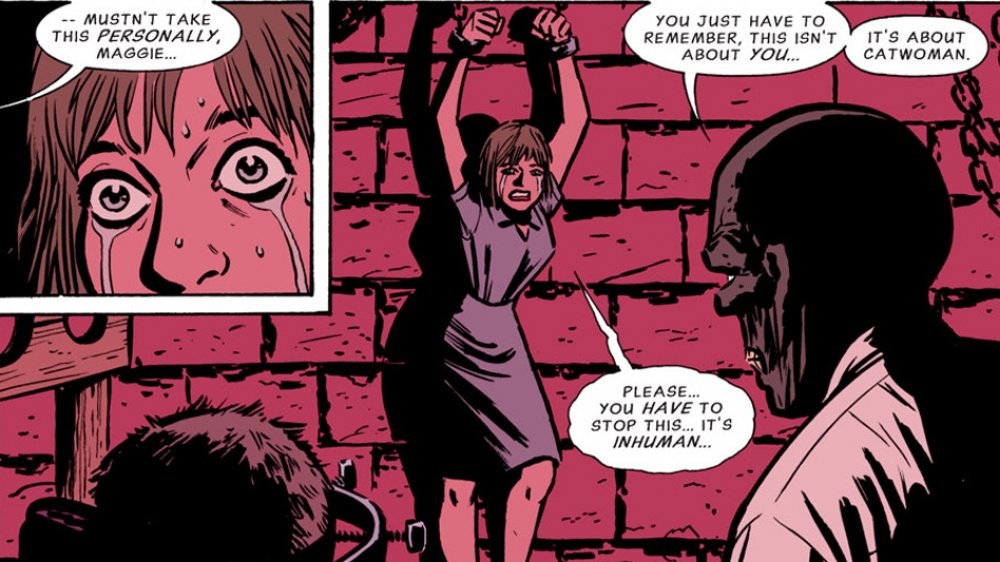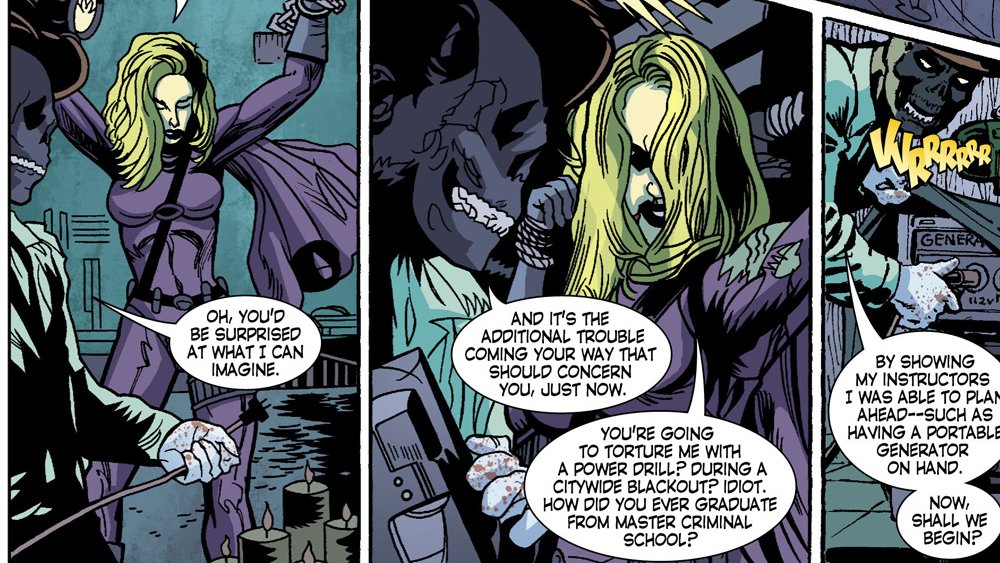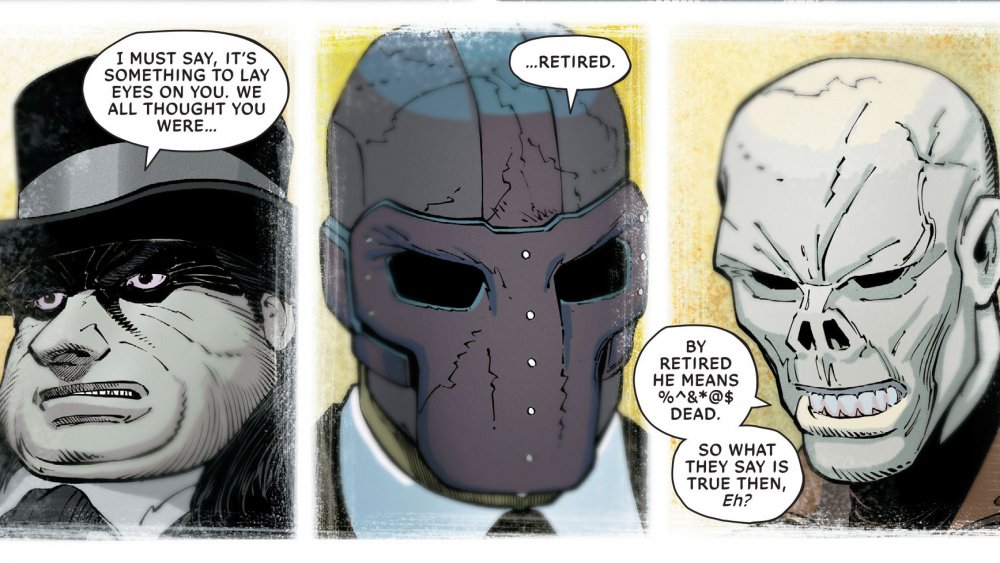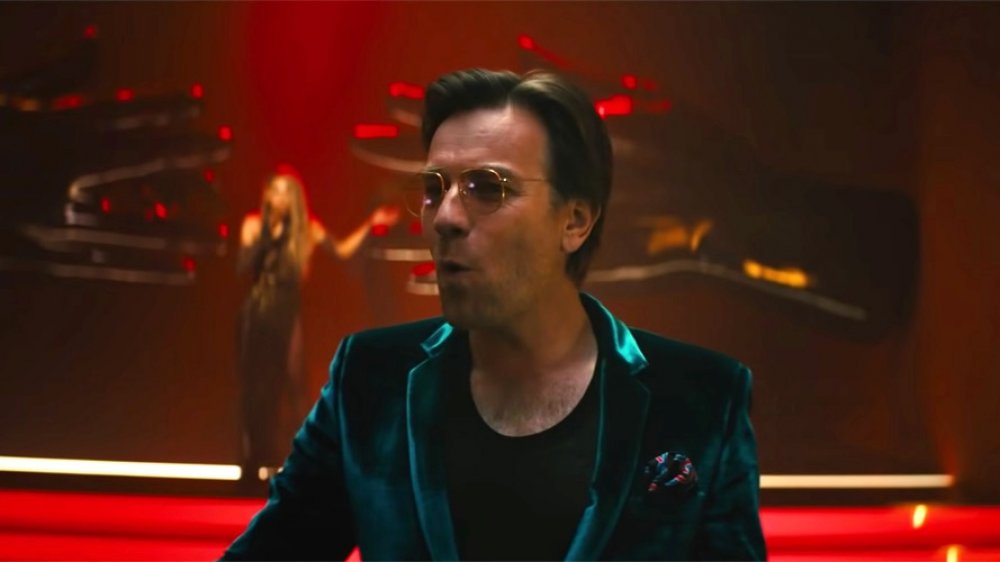The Untold Truth Of Black Mask
Aside from Harley Quinn, who burst out of the small screen to become one of DC's most marketable characters, most of the big-name Batman villains go back a pretty long way. Joker and Catwoman debuted in 1940, and the rest of the decade brought the Penguin, Two-Face, and the Riddler. Even Deadshot, who really became a breakout character in the '80s in stories that led to him being featured alongside Harley in a major motion picture, goes back to 1950.
One of the more recent creations to step into the spotlight, though, is Black Mask. While he didn't immediately hit the big time when he was introduced in the '80s, recent years have seen him become the go-to Batman villain for a story that needs a crime boss, from the Arkham Origins video game to Ewan McGregor's performance on the big screen in the Birds of Prey film. The question, of course, is how did this latecomer to the supervillain game go from a minor gimmicky crime boss to the top-tier Bat-foe that he is now? From small-time crook to full-blown cult leader, here's the truth behind Roman Sionis, better known as Black Mask.
The bad Bruce Wayne
From Cat-Man and Killer Moth to the Wrath and Prometheus and all the way to the recent stories of the Batman Who Laughs, the Dark Knight's stories have a long history of villains who are basically just "what if Batman was a bad guy?" When Roman Sionis was introduced in in 1985's Batman #386, however, it was as the answer to a slightly different question: what if Bruce Wayne was a bad guy?
Black Mask's first appearance definitely shows some of the signs of its age. It literally opens, for example, with a scene showing Roman being dropped on his head as a baby, which gave him "a certain dullness which never really concealed the burning," and he was then bit by a rabid raccoon (no really). Both of those incidents are counted as reasons for his later insanity, which, yikes. Beyond that, the way that he's paralleled with Bruce is actually really interesting. Behind a cover that touted their new creation as "Crazier than the Joker! Deadlier than Ra's al-Ghul!'" — which, let's be honest here, is overselling things just a little bit — Doug Moench and Tom Mandrake told the story of a boy born to another one of Gotham City's wealthiest families. Unlike the charitable and morally upstanding Waynes, though, the Sionis family was a nest of vipers who were far more concerned with keeping up appearances than with anything resembling morality. Bruce and Roman even knew each other as children, and they were also both profoundly affected by the deaths of their parents. Of course, in Roman's case, it was because he was the one who killed them, which is a pretty drastic departure from what the Wayne boy was up to down the street.
They'd later find themselves tied together in their adult lives. Roman inherited his family's cosmetics company; unfortunately for him, he was a much better murderer than a businessman, and after a series of catastrophically bad business decisions, including marketing a waterproof makeup that caused horrifying skin conditions for its users, the Wayne Foundation bailed out Roman's company on the condition that he step down as CEO. Before long, the two children of privilege would be clashing far from the board room.
Enter: Black Mask
Being given the boot from his family business sent Roman over the edge, and in the throes of a madness that was pretty intense even by Gotham City standards, he found himself smashing up his mother's ornate ebony coffin. That act was combined with his lifelong obsession with masks, leading him to carve the shard of the coffin into the mask that would give him his name. With that, Roman Sionis, failed businessman, was no more, and in his place came Black Mask, murderous crime boss and part-time cult leader.
From the very beginning, Black Mask was more on the side of obsessive homicidal supervillain than, say, the quirky bank robber arch-criminals like the Riddler. Rather than henchmen, he surrounded himself with the "False Face Society," insisting that all of his henchmen undergo "the death of your identities" and embrace the personae given to them by their new masks. He even went as far as using the banned cosmetics to disfigure his ex-girlfriend, roping her into his criminal web too. By the end of that first three-part story arc, he underwent a similar fate himself when he tried to burn down his childhood home and, as Moench dramatically put it, fell "mask-down in the cremation of his past." With that, the ebony mask was burned to his face, permanently altering his appearance to his villainous identity.
Even with all that, Black Mask's focus was always on obtaining the success that he felt had been denied to him as Roman Sionis. He wanted to build a criminal empire, which led to him being pretty consistently depicted in the role of an organized crime boss, and not just someone who breaks out of Arkham, leaving swaths of thematic murders in his wake. Then again, it says a lot about Gotham City that even the people behind their regular mobster-style crimes are dramatic, psychologically broken megalomaniacs with signature accessories.
Bullock's Law
Black Mask had the misfortune of being one of the last new Bat-villains to appear before the DC Universe was completely reorganized in 1985 with Crisis on Infinite Earths. In the rush to reinvent the classic Batman villains, Black Mask was lost in the shuffle, fading into the background of Gotham's supervillain community. Still, the idea of a character who straddled the line between organized crime lord and full-on supervillain made him a handy character to have around, especially since he had a built-in reason to target Bruce Wayne.
Over a decade after he was introduced, Black Mask got what was arguably his second big role in 1999's Batman: Bullock's Law, which plays up the more traditional gangster side of Black Mask. The story focuses on Harvey Bullock, the slovenly, rule-bending detective partnered up with Renee Montoya since her introduction in Batman: The Animated Series, who gets an offer he can't refuse from Black Mask. The crime lord hands Bullock a file full of information on every other criminal organization in Gotham, with the understanding that Bullock and the rest of the GCPD will have no choice but to use the file to take down all of his competition, leaving the False Face Society alone and, incidentally, putting the relatively clean Bullock in debt to the last crime lord standing.
It won't surprise you to learn that things work out a little differently than Black Mask planned, but the story served as his reintroduction — and established him as a major player in Gotham's underworld, just in time for his character to take a big leap forward.
No Man's Land
The No Man's Land storyline is one of the most ambitious projects in Batman's considerable history: a story spread out over multiple series that was essentially told in real time, taking up an entire year with at least one new issue hitting every single week, plus various specials and tie-ins. The idea was essentially a post-apocalyptic Batman story, and it pulled off that premise about as well as it could. After a massive earthquake hit Gotham, the government decided that rather than spending the money to rebuild, they'd just evacuate the city and write it off. The problem, of course, was that not everyone could make it out, and when the city was abandoned, it was left to the supervillains who had escaped from Arkham to carve it up into their own little Mad Max-style kingdoms.
Bits and pieces of that story have shown up in various places, including as a part of The Dark Knight Rises and the Batman: Arkham City video game, and even became a big element of the most recent version of Batman's origin story, Zero Year. For Black Mask, it also set the stage for him to be reborn as a much more terrifying figure.
Having escaped Arkham, Black Mask did more than just recruit a gang and take over a few blocks. He re-established the False Face Society as a full-blown cult, preaching that the cataclysmic quake that shattered Gotham had, in fact, revealed its true face. To that end, he ditched the mask and disfigured himself even further, inspiring his followers to do the same and coming away from it with a new look that saw his own head resembling more of a charred skull than a living human. It also gave him a new interest that would become a much more violent and disturbing signature in the next few years.
East Ender
Despite his connection to Bruce Wayne, Black Mask's rise to true villainous prominence didn't involve a clash with Batman — at least, not directly. Instead, it came when he set himself up as the crime boss of a Gotham City neighborhood that was notoriously crime-ridden even by that town's standards: the East End. Unfortunately, the East End had fallen under the protection of Catwoman, who had taken up the vigilante life in order to protect her home, staking a claim on the neighborhood and assuming responsibility for it, with even Batman agreeing to leave her to it. This would not work out well for anyone involved.
While he shifted back to organized crime after his tenure as a cult leader during No Man's Land, Black Mask's obsession with disfiguring people with things like hot pokers stuck with him, making him an exceptionally sadistic villain. He'd taken a keen interest in the medieval torture techniques, particularly those used by the Spanish Inquisition. He stocked his penthouse with all manner of horrific medieval devices, keeping his minions — and his rivals — in line through fear. After, all, a guy like the Joker would absolutely kill you for no other reason than he felt like it, but Black Mask? He'd take his time with it, and savor every second.
These weren't just idle threats, either. Catwoman Secret Files #1 casually revealed that Black Mask had executed someone with an iron maiden just on the suspicion of betrayal, after which he happily flayed another suspected traitor alive while literally singing a jaunty tune. It was grim stuff, but it set the tone for Black Mask going forward, and it would only get worse as it went.
Sister sister
Given his particular tendencies, it won't come as a surprise to learn that Black Mask didn't confront Catwoman directly. Instead, after she got in his way, Black Mask decided to hurt Catwoman in a way that would be far worse than just attacking her. He went after her friends and family.
In addition to targeting Slam Bradley and Holly Robinson — Catwoman's romantic interest at the time and her sidekick, respectively — Black Mask kidnapped Catwoman's estranged sister. Maggie Kyle had led a very different life from her sister Selina, and Catwoman had done her best to separate her sister's life from her own very dangerous profession of thief/vigilante/occasional supervillain. When Black Mask learned about Maggie's connection to Catwoman, though, he abducted her and her husband. He then chained them both up in his dungeon, and forced Maggie to both watch and participate while he tortured her husband to death in one of the most gruesome, harrowing scenes ever committed to the page. The horror of it was only compounded by Black Mask's casual attitude, even telling Maggie that all of her suffering was "because someone told me it would hurt Catwoman if I ruined your life. Okay?"
The experience left Maggie psychologically broken and Catwoman understandably enraged, to the point where she beat Black Mask down and then kicked him off a building to his apparent death. The keyword there, of course, is "apparent" — despite Catwoman's definite intention and Black Mask's long fall from his penthouse, the villain survived, making his way to Arkham Asylum and turning himself in for treatment that wound up saving his life. With that, Black Mask became one of the few villains to ever voluntarily commit himself to Arkham, which, amazingly, isn't even his top three most insane acts.
You know the drill
His role as Catwoman's nemesis had redefined him as one of Gotham City's most vicious arch-criminals. A few years later, the War Games storyline would put Black Mask on a level that only the Joker had gotten to before when he became the second villain to kill a Robin. Sort of.
The Robin in question was Stephanie Brown, who had briefly served as Batman's sidekick after Tim Drake quit. When Tim resumed his role as Robin, Stephanie was demoted back down to her previous heroic identity, Spoiler — who, shockingly, only recently began yelling "Spoiler alert!" when she crashed through windows. In an ill-fated attempt to get back into Batman's good graces, she enacted one of his contingency plans, inadvertently sparking a gang war that nearly tore the city apart. Black Mask was one of the chief players in the conflict, and when Stephanie attempted to help stop the gang war, he kidnapped her and apparently tortured her to death with a power drill.
The fan response to this was... not great. Fans at conventions constantly asked about the storyline, with a particular emphasis on why Stephanie wasn't given a proper memorial in the Batcave, like Jason Todd, the Robin who had been killed by the Joker. Eventually, Stephanie's death was retconned with a story that revealed it had been faked by Leslie Thompkins, one of Batman's closest allies, in an effort to get the Dark Knight to stop putting children in danger. Batman was said to have suspected this all along, hence never building her a memorial, which is a pretty flimsy excuse. Still, Black Mask's part in Spoiler's "death," and his status as the last crime boss left standing after War Games, put him into rarified air among Batman villains.
The Black & Whites
Black Mask later solidified his control on Gotham CIty's criminal underworld by teaming up with a few other villains in an alliance that's not only based on their role in organized crime, but also their monochromatic color schemes.
The trio are appropriately known as the Black and Whites: Black Mask, the Penguin, and the Great White. You're probably already familiar with the Penguin, but if you only know him from his film and television appearances, you might not know that he gave up on umbrella-based shenanigans a while back, instead hiding his criminal activities behind the facade of a "legitimate businessman." As the owner of the Iceberg Lounge, a Gotham City nightclub, he's still at the center of the city's criminal underworld, just in a less active way.
Great White, on the other hand, has some similarities to Black Mask himself. Warren White was a white-collar criminal who was put on trial for his various Ponzi schemes and had the brilliant idea of pleading insanity to get out of it. In Gotham City, you can see how this would be a terrible idea. Sure enough, the judge saw through the ruse and decided to send him to Arkham alongside supervillains who, you know, ate people. He wound up being locked in a freezer, losing his nose to frostbite, and emerging as exactly the kind of villain that he was pretending to be. With his white-collar crimes, the Penguin's legitimate front, and Black Mask's terrifying, overt criminal activities, the three villains soon had Gotham's "regular" crime — as opposed to crossword puzzle murders or whatever Two-Face is doing this week — taken care of.
Off the page and onto the screen
Black Mask occupies a pretty unique place in Batman's canon. He's a mobster, a sadistic supervillain, a gimmicky bad guy with a strong look, and a dark reflection of Bruce Wayne all at once. With that in mind, it probably shouldn't be surprising that recent years have seen him becoming one of the go-to villains for Batman stories outside of the comics page.
The most prominent is undoubtedly the Birds of Prey movie, but Roman Sionis has also been used prominently elsewhere. He was featured prominently as the main villain of the Arkham Origins video game, although the twist was that it eventually turned out to be the Joker disguised as Black Mask. Also, while Roman himself wasn't used on the show, his father Richard appeared as a villain in the first season of Gotham, establishing that the False Face Society was something of a family business.
As for Ewan McGregor's performance in Birds of Prey, what we've seen of the movie so far would seem to indicate that Roman's mask in this one is more of a metaphorical one, although he does seem to have the flair for drama and sadistic streak of his comic book counterpart. Either way, considering that his greatest enmity has been reserved towards women in the comics — both Catwoman and Spoiler being the prime examples, along with his ex-girlfriend Circe all the way back in his first appearance — he makes for a solid choice to fight a group of female vigilantes on the big screen.
